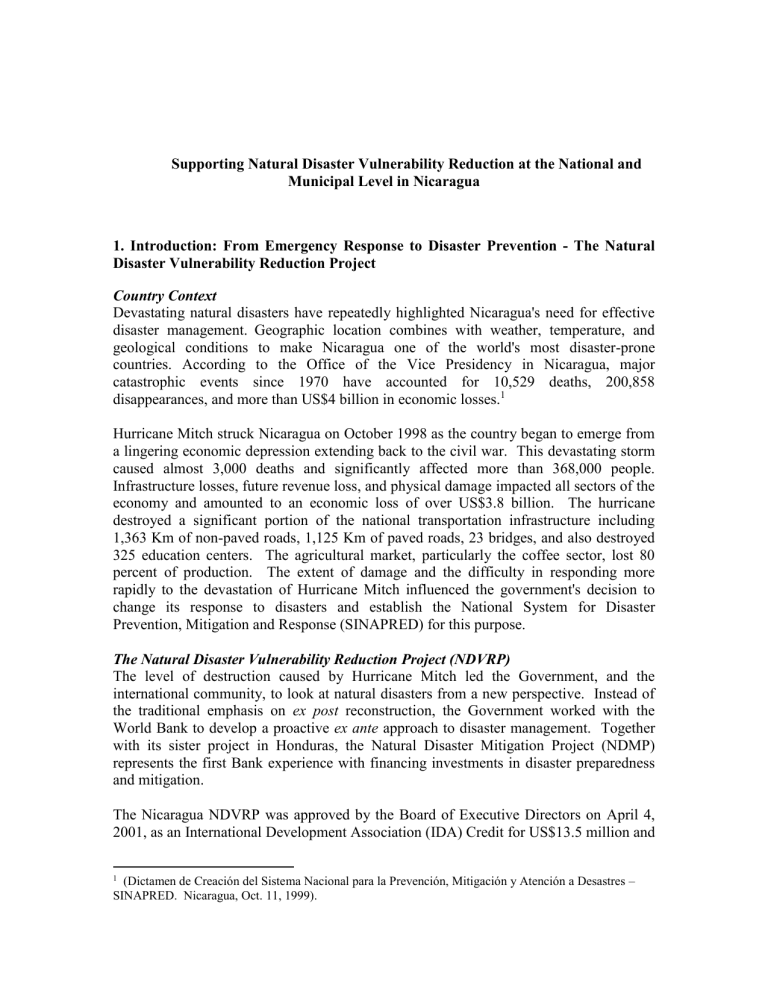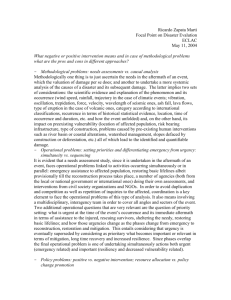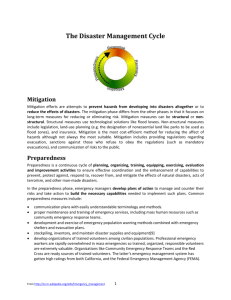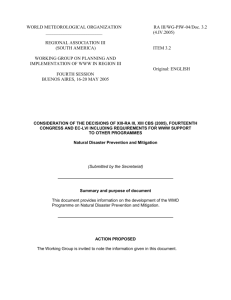Supporting Natural Disaster Vulnerability Reduction at the National

Supporting Natural Disaster Vulnerability Reduction at the National and
Municipal Level in Nicaragua
1. Introduction: From Emergency Response to Disaster Prevention - The Natural
Disaster Vulnerability Reduction Project
Country Context
Devastating natural disasters have repeatedly highlighted Nicaragua's need for effective disaster management.
Geographic location combines with weather, temperature, and geological conditions to make Nicaragua one of the world's most disaster-prone countries. According to the Office of the Vice Presidency in Nicaragua, major catastrophic events since 1970 have accounted for 10,529 deaths, 200,858 disappearances, and more than US$4 billion in economic losses.
1
Hurricane Mitch struck Nicaragua on October 1998 as the country began to emerge from a lingering economic depression extending back to the civil war. This devastating storm caused almost 3,000 deaths and significantly affected more than 368,000 people.
Infrastructure losses, future revenue loss, and physical damage impacted all sectors of the economy and amounted to an economic loss of over US$3.8 billion. The hurricane destroyed a significant portion of the national transportation infrastructure including
1,363 Km of non-paved roads, 1,125 Km of paved roads, 23 bridges, and also destroyed
325 education centers. The agricultural market, particularly the coffee sector, lost 80 percent of production. The extent of damage and the difficulty in responding more rapidly to the devastation of Hurricane Mitch influenced the government's decision to change its response to disasters and establish the National System for Disaster
Prevention, Mitigation and Response (SINAPRED) for this purpose.
The Natural Disaster Vulnerability Reduction Project (NDVRP)
The level of destruction caused by Hurricane Mitch led the Government, and the international community, to look at natural disasters from a new perspective. Instead of the traditional emphasis on ex post reconstruction, the Government worked with the
World Bank to develop a proactive ex ante approach to disaster management. Together with its sister project in Honduras, the Natural Disaster Mitigation Project (NDMP) represents the first Bank experience with financing investments in disaster preparedness and mitigation.
The Nicaragua NDVRP was approved by the Board of Executive Directors on April 4,
2001, as an International Development Association (IDA) Credit for US$13.5 million and
1 (Dictamen de Creación del Sistema Nacional para la Prevención, Mitigación y Atención a Desastres –
SINAPRED. Nicaragua, Oct. 11, 1999).
became effective on October 16, 2001. The project coverage was defined following a careful study of comparative vulnerability among Nicaragua's 151 municipalities and an assessment of institutional capacity within the National System. While the project aims to cover all the municipalities in terms of emergency preparedness and response, the complementary but more costly activities associated with prevention and mitigation have been initially implemented on the twenty five most vulnerable municipalities. Given the pattern of natural events in Nicaragua, most groups living at risk occupy marginal urban settlements and rural communities and are poor. The selection process used to identify highly vulnerable municipalities included a poverty analysis as well as hazard risk mapping.
The objective of the NDVRP is to improve Nicaragua’s disaster management capacity by: (a) strengthening institutional capacity in disaster management at the national level;
(b) building institutional capacity for disaster mitigation at the national level; (c) promoting disaster awareness and ‘preventive thinking’ throughout public sector education and awareness programs; (d) building local capacity to manage disaster emergencies, to assess risk and to identity mitigation measures; and (e) implementing vulnerability reduction and mitigation measures at the local level.
At the national level, project activities include: strengthening disaster prevention, preparedness and response, through SINAPRED and the Executive Secretariat leading it by providing technical assistance and necessary equipment, and covering expenses for key studies and initial operating costs. The NDVRP has also financed engineer designs and civil works for three buildings in order to provide the Executive Secretariat, the
Emergency Operations Center, and the Civil Defense Institution with suitable operative space and infrastructure. To address the need for a national mitigation strategy, the project supports the SINAPRED’s inter-institutional commission, by providing them with information management systems and resources to conduct key studies to define their mitigation policies and future mitigation activities.
To bring disaster awareness into public practice, the NDVRP has supported the national efforts to integrate these issues in the national curricula for the formal education system, as well as a disaster awareness campaign for the general public through the national media. At the local level, the project supports emergency preparedness by assuring the organization, training and adequate equipment of emergency response committees in all municipalities. In addition, mitigation efforts have been implemented in twenty five municipalities, selected as the most vulnerable to natural disasters, by carrying out technically supported risk assessments and vulnerability analyses and subsequently developing "preventive" land use plans and specific disaster mitigation programs.
The NDVRP provides financing to implement a number of high-impact, priority mitigation measures identified in the twenty five target municipalities. Complementing studies with structural measures was a key part of the project since the beginning, as national and local government representatives in Nicaragua clearly highlighted that analyzing risks is much more effective if accompanied by the implementation of prevention and mitigation measures (structural and non). Indeed, Hurricane Mitch
altered river courses and weakened hillsides in many areas of the country. Adequate reparations have been necessary, and many more are needed, as many communities still remain vulnerable to a new round of disasters. Experiences with local planning and investment, even before Mitch, suggest that unless funds are specifically targeted, local governments will postpone investments in disaster mitigation and prevention.
The incorporation of vulnerability analysis and disaster planning into land use and municipal development plans represents a major step for disaster risk reduction, as are also the adoption of vulnerability analyses and mitigation measures into municipal planning practices as promoted by the country’s Social Emergency Fund (FISE).
Results from NDVRN
The NDVRN has been fully supportive of the country’s efforts to institutionalize disaster risk prevention and mitigation through SINAPRED, and of its focus on the implementation of non-structural and structural mitigation measures at the local level.
By August 2008, 30 municipalities have developed and approved Municipal Territorial
Plans and Municipal Disaster Risk Management (DRM) plans, and most of these municipalities are using the instruments designed for preventive planning, especially when it comes to new building licenses. Additionally, the 30 municipalities have shown that these instruments are having a greater impact than expected. For example, the maps for the municipalities produced under the project have been used by the Ministries of
Health, Education, and Development planning. Moreover, SINAPRED has been institutionalized and has developed a brand that is recognized in the country and the region as the national system for disaster reduction.
Additionally, final designs have been produced for Mitigation Works in 30
Municipalities, 15 of which have already been constructed by the project, through the
Social Emergency Fund. The works and equipment component has provided the country with infrastructure to support the operations of SINAPRED.
II. Country Progress
Despite previous government efforts, the extent of Hurricane Mitch damage in October of
1998 revealed the lack of both local response capacity and of coordination to manage a more integrated national response. Since then, one of the principal institutional reforms achieved by Nicaragua concerns the establishment of the SINAPRED and the Executive
Secretariat as its coordinating authority. The creation of this institution under the Law
#337 in 2000 represents an important policy change insofar as the Executive Branch of
National Government has taken responsibility for disaster management and has made disaster preparedness and mitigation issues a matter of public sector mandate.
III. Key barriers and challenges
The most successful and innovative element of the World Bank project in Nicaragua has been the creation of capacity at the local level for the preventive planning process. It is
often the responsibility of the municipality to develop and enforce territorial planning and building codes, as well as to rehabilitate and maintain infrastructure and services that may be affected by recurrent adverse natural events. This achievement is particularly significant given that, in most cases, decentralization of responsibilities from the national to the local level is often not accompanied by sufficient decentralization of capacities and resources.
The long-term objective of the interventions in Nicaragua is to strengthen the country’s institutional capacity for disaster preparedness and management and to integrate disaster mitigation into the local development process, based on sound and informed risk assessments. The vulnerability maps produced under the project are being used as inputs to the municipalities’ spatial and development plans and land use planning. As experiences in other countries have demonstrated, the local level is the most critical link in identifying vulnerabilities and preparing prevention/mitigation action plans. The biggest challenge is the lack of financial resources at the local level for prevention, which is particularly acute in a country that has many other immediate needs.
IV. Way forward
The government of Nicaragua is making an effort to institutionalize preventive planning at the local level and is looking for additional resources to implement vulnerability risk reduction activities. On September 2007, the Hurricane Felix hit the Caribbean Coast of
Nicaragua, in the RAAN (Región Autónoma del Atlántico Norte), and the government of
Nicaragua received an Emergency Recovery Credit from the World Bank for SDR10.7 millions, for rehabilitation and reconstruction of social infrastructure and housing, and institutional strengthening of the government of RAAN. The main objective of this project is to support the sustainable recovery of the affected communities by Hurricane
Felix, using the experience of the National System and promoting preventive planning in new infrastructure. The initiative taken by local governments, together with guidance and resources from the central government, is a very welcome development that shows that the government is committed to continue strengthening its capacity to manage disaster risk and to invest in vulnerability reduction.
Local level disaster risk reduction in Nicaragua: Through it’s Natural Disaster Vulnerability Reduction
Project (NDVRP), the World Bank has supported the government of Nicaragua to strengthen the National
System for Disaster Prevention, Mitigation and Response (SINAPRED)at both national and local levels.
SINAPRED is a multi-sector, decentralized disaster risk reduction system, created in 1999 with the support of UNDP, after Hurricane Mitch revealed once again the high vulnerability of Nicaragua to extreme hazard events. In the most high risk municipalities, the project supported risk assessments and vulnerability analyses, the development of risk-sensitive land use plans as well as specific structural and non-structural mitigation measures. By August 2008, 30 municipalities had developed and approved Municipal Territorial
Plans and Municipal Disaster Risk Management (DRM) plans, and most are using these instruments to grant new building licenses. Additionally, the maps for the municipalities produced under the project have been used by the Ministries of Health, Education, and Development planning. Mitigation measures in 15 municipalities have been funded through a social fund (FISE). Whether the results achieved can be sustained without additional international resources, however, is open to question. Despite it’s sophisticated legal and administrative structure SINAPRED has access to very limited budget allocations. A recent study by the Interamerican Development Bank and the Economic Commission for Latin America and the
Caribbean (ECLAC) indicate that it’s functioning is seriously impaired by financial and institutional limitations. At the municipal level resources budget allocations are also very limited.






